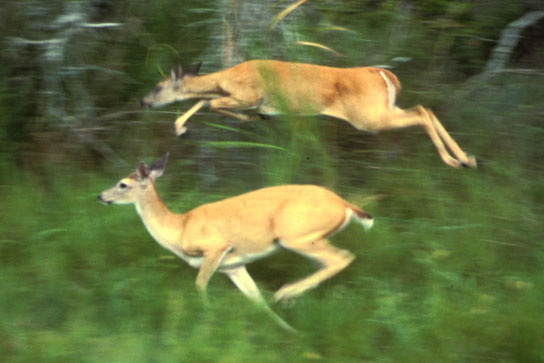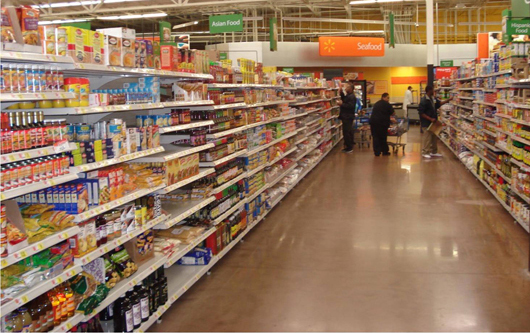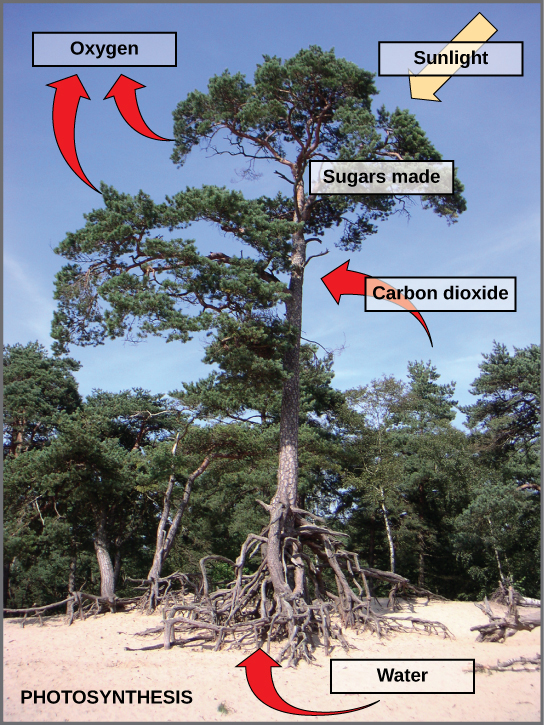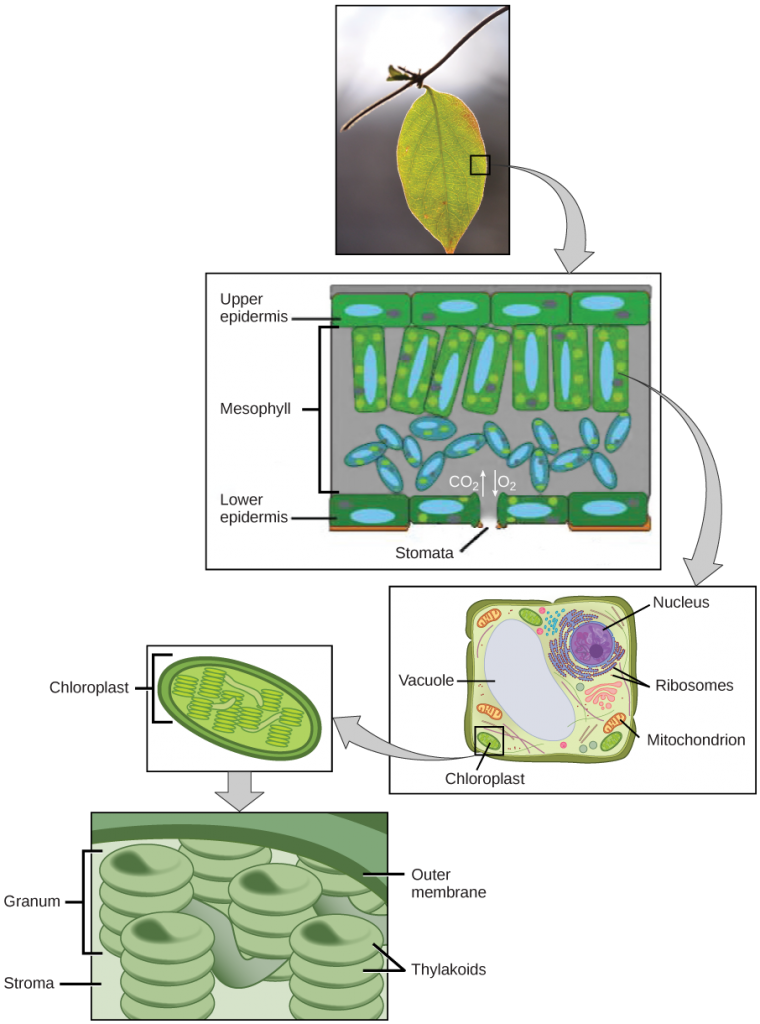Where Do Plants Obtain the Oxygen Necessary to Utilize Foods?
Chapter 5: Introduction to Photosynthesis
5.1: Overview of Photosynthesis
Learning Objectives
By the end of this section, you will beryllium able to:
- Summarize the process of photosynthesis
- Explain the relevancy of photosynthesis to other living things
- Identify the reactants and products of photosynthesis
- Describe the main structures involved in photosynthesis
All life organisms on earth consist of united or more than cells. Each electric cell runs happening the chemical energy base principally in carbohydrate molecules (food), and the majority of these molecules are produced by one and only process: photosynthesis. Through with photosynthesis, certain organisms convert solar energy (sunlight) into chemical energy, which is then accustomed build carbohydrate molecules. The vim wont to hold these molecules put together is released when an organism breaks dispirited intellectual nourishment. Cells then use this energy to perform work, such as respiration.
The energy that is harnessed from photosynthesis enters the ecosystems of our planet continuously and is transferred from one organism to another. Therefore, directly or indirectly, the swear out of photosynthesis provides most of the energy required away living things on earth.
Photosynthesis also results in the release of oxygen into the atmosphere. In squat, to eat on and breathe, humans depend just about entirely on the organisms that carry out photosynthesis.
Construct in Litigate

Mouse click the following link to learn more active photosynthesis.
Solar Dependence and Food Production
Some organisms can carry unsuccessful photosynthesis, whereas others cannot. An autotroph is an organism that lavatory garden truck its own food. The Greek roots of the word autotroph average "self" (auto) "feeder" (troph). Plants are the known autotrophs, but others exist, including certain types of bacterium and algae (Figure 5.2). Oceanic algae contribute big quantities of food and oxygen to global food chains. Plants are also photoautotrophs, a type of autotroph that uses sunlight and carbon from CO2 to synthesise chemical energy in the form of carbohydrates. All organisms carrying out photosynthesis require sunlight.

Heterotrophs are organisms incapable of photosynthesis that must consequently obtain energy and atomic number 6 from food by consuming other organisms. The Greek roots of the word heterotroph mean "other" (hetero) "feeder" (troph), meaning that their food comes from other organisms. Eve if the food organism is another animal, this food traces its origins backward to autotrophs and the treat of photosynthesis. Humans are heterotrophs, as are all animals. Heterotrophs count on autotrophs, either directly or indirectly. Deer and wolves are heterotrophs. A deer obtains energy aside eating plants. A wolf eating a deer obtains energy that originally came from the plants eaten away that cervid. The energy in the works came from photosynthesis, and thence it is the only autophytic plant in this example (Figure 5.3). Using this reasoning, all food eaten by humans also golf links back to autotrophs that carry out photosynthesis.

Biology in Action
Photosynthesis at the Grocery store Store

John R. Major grocery stores in the United States are organized into departments, such as dairy farm, meats, produce, bread, cereals, and so forth. Each gangway contains hundreds, if non thousands, of different products for customers to buy and consume (Figure 5.4).
Although there is a large variety, each detail links back to photosynthesis. Meats and dairy farm products link to photosynthesis because the animals were fed plant-based foods. The breads, cereals, and pastas come largely from grains, which are the seeds of photosynthetic plants. What about desserts and drinks? Wholly of these products stop sugar—the basic saccharide corpuscle produced directly from photosynthesis. The photosynthesis connection applies to every meal and every food a person consumes.
Main Structures and Summary of Photosynthesis
Photosynthesis requires sunlight, carbon copy dioxide, and water A starting reactants (Figure 5.5). Afterwards the process is unadulterated, photosynthesis releases oxygen and produces carbohydrate molecules, most commonly glucose. These saccharify molecules contain the energy that life things need to subsist.

The coordination compound reactions of photosynthesis hind end follow summarized by the material equation shown in Figure 5.6.

Although the equation looks simple, the many steps that take place during photosynthesis are actually quite an complex, every bit in the way that the reaction summarizing cell-like cellular respiration delineated many an individual reactions. Before acquisition the details of how photoautotrophs go sunshine into food, information technology is important to become familiar with the physical structures implicated.
In plants, photosynthesis takes place primarily in leaves, which consist of many layers of cells and have differentiated top and bottom sides. The process of photosynthesis occurs non on the grade-constructed layers of the leaf, but instead in a midriff layer called the mesophyll (Public figure 5.7). The gas exchange of carbon dioxide and oxygen occurs through small, organized openings called stomata.
In all autotrophic eukaryotes, photosynthesis takes spot inside an organelle called a chloroplast. In plants, chloroplast-containing cells exist in the mesophyll. Chloroplasts have a duple (inner and outer) membrane. Within the chloroplast is a tierce membrane that forms stacked, disc-shaped structures called thylakoids. Embedded in the thylakoid membrane are molecules of chlorophyll, a pigment (a molecule that absorbs light) through which the stallion process of photosynthesis begins. Chlorophyll is causative for the super acid color of plants. The thylakoid membrane encloses an inward space called the thylakoid space. Unusual types of pigments are too entangled in photosynthesis, but chlorophyl is by faraway the most momentous. As shown in Figure 5.7, a stack of thylakoids is called a granum, and the space close the granum is called stroma (not to be confused with stomata, the openings along the leaves).

On a hot, dry Clarence Day, plants close their stomata to conserve water. What impact will this receive on photosynthesis?
The Two Parts of Photosynthesis
Photosynthesis takes place in two stages: the light-dependent reactions and the Calvin cycle. In the light-dependent reactions, which pass at the thylakoid membrane, chlorophyll absorbs push from sunlight so converts it into chemical energy with the use of water. The light-dependent reactions release oxygen from the hydrolysis of water as a byproduct. In the Calvin cycle, which takes place in the stroma, the chemical energy derived from the light-dependent reactions drives both the capture of carbon in carbon dioxide molecules and the later assembly of sugar molecules. The 2 reactions use carrier molecules to transport the energy from uncomparable to the other. The carriers that move energy from the light-dependent reactions to the Calvin cycle reactions can be mentation of as "full" because they bring energy. After the energy is free, the "vacate" energy carriers return to the light-supported reactions to find Sir Thomas More energy.
Section Summary
The process of photosynthesis transformed life on world. By harnessing Energy Department from the sun, photosynthesis allowed living things to access enormous amounts of energy. Because of photosynthesis, living things gained access to sufficient energy, allowing them to evolve new structures and achieve the biodiversity that is evident today.
Single certain organisms, titled autotrophs, lavatory perform photosynthesis; they require the front of chlorophyll, a technical pigment that can absorb light and convert visible radiation muscularity into chemical energy. Photosynthesis uses carbonic acid gas and water supply to assemble carbohydrate molecules (unremarkably glucose) and releases oxygen into the air. Eukaryotic autotrophs, such as plants and algae, have organelles called chloroplasts in which photosynthesis takes place.
Glossary
autotroph: an being susceptible of producing its own food
chlorophyll: the green pigment that captures the light Energy Department that drives the reactions of photosynthesis
chloroplast: the organelle where photosynthesis takes office
granum: a good deal of thylakoids located inside a chloroplast
heterotroph: an organism that consumes other organisms for food for thought
light-dependent reaction: the foremost arrange of photosynthesis where visible bright is absorbable to form two energy-carrying molecules (ATP and NADPH)
mesophyll: the middle layer of cells in a rif
photoautotroph: an organism capable of synthesizing its possess intellectual nourishment molecules (storing energy), using the DOE of clean
pigment: a molecule that is capable of gripping light energy
stoma: the opening that regulates gas exchange and piddle regularisation between leaves and the surroundings; dual: stomata
stroma: the fluid-filled space surrounding the grana in spite of appearanc a chloroplast where the Calvin cycle reactions of photosynthesis take place
thylakoid: a disklike membranous structure inside a chloroplast where the light-dependent reactions of photosynthesis take put away victimisation chlorophyll integrated in the membranes
Where Do Plants Obtain the Oxygen Necessary to Utilize Foods?
Source: https://opentextbc.ca/biology/chapter/5-1-overview-of-photosynthesis/
0 Response to "Where Do Plants Obtain the Oxygen Necessary to Utilize Foods?"
Publicar un comentario